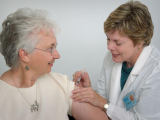Apr 12, 2013
CDC posts H7N9 guidance for healthcare personnel
The US Centers for Disease Control and Prevention (CDC) yesterday released interim guidance for healthcare personnel (HCP) caring for confirmed, probable, or cases under investigation for H7N9 avian flu infection. The CDC recommends a higher level of infection control than for seasonal flu, including a higher level of personal protective equipment for HCP that involves eye protection and use of respirators for all patient-care activities. The H7N9 guidance details eight steps for preventing transmission: (1) minimize exposures, (2) implement engineering controls such as physical barriers around patients, (3) manage ill and exposed HCP, (4) train and educate HCP, (5) ensure adherence to infection control practices, (6) implement environmental infection control, (7) manage visitor access, and (8) monitor severe respiratory infections. The guidance takes into consideration a lack of a targeted vaccine, a "suspected high rate of morbidity
and mortality," unknown potential for human-to-human transmission, and the absence of a confirmed or probable H7N9 case in the United States.
Apr 11 CDC interim guidance
Nearly 5,000 swifts die of H5N1 in Vietnam
Almost 5,000 swifts, whose nests are used in bird's nest soup and other specialty foods, died from H5N1 avian flu in a facility in southern Vietnam, according to Thailand's The Nation newspaper. The birds are half the nesting population at the facility, in Phan Rang Thap Cham City, which has many "bird houses," where swifts are encouraged to build their nests, largely composed of the swifts' saliva, which are then collected and sold. "My experiences show if swifts contract H5N1, it would be very difficult to control because most of the birds fly all over the place and only come back to the house in the evening," said facility owner Nguyen VanKhoi.
Apr 12 Nation story
US flu activity continues to taper, but 5 more kids' deaths reported
US influenza activity continued its late-season drop last week, but five new pediatric flu deaths were reported, bringing that total to 116, the CDC reported in its weekly update today. The proportion of outpatient visits for flulike illness was 1.5%, down from 1.8% the week before and below the national baseline of 2.2%. The proportion of deaths attributed to pneumonia and influenza fell to 7.2% from 7.4% the week before, and below the epidemic threshold of 7.4%. Four states reported widespread flu activity and seven regional activity, the same numbers reported in the previous week. Of 441 samples that tested positive for flu, 71% were influenza B and 29% influenza A, a slight rise in the proportion of "A" strains from the week before. No recently identified viruses were found resistant to antiviral drugs. Updates from the Pan American Health Organization (PAHO) and the European Centre for Disease Prevention and
Control (ECDC) reported similar low flu levels.
Apr 12 CDC update
Apr 10 PAHO update
Apr 12 ECDC update
Large study finds no evidence of higher GBS risk with any vaccine
Risk of Guillain-Barre syndrome (GBS) did not increase with vaccination of any kind, including flu vaccine, a large retrospective study in Clinical Infectious Diseases yesterday found. Investigators identified 415 GBS cases from Kaiser Permanente Northern California patient data from 1995 through 2006. They determined that the odds ratio of influenza vaccination within 6 weeks prior to GBS compared with the previous 9 months was 1.1 (95% confidence interval [CI], 0.4-3.1). The risk in the 6-week interval compared with the previous 12 months for tetanus diphtheria combination, for 23-valent pneumococcal polysaccharide, and for all vaccines combined was 1.4 (95% CI, 0.3-4.5), 0.7 (95% CI, 0.1-2.9), and 1.3 (95% CI, 0.8-2.3), respectively.
Apr 11 Clin Infect Dis abstract
WHO, UNICEF launch global plan to combat pneumonia, diarrhea
The World Health Organization (WHO) and UN Children's Fund (UNICEF) today launched a global action plan to prevent and control pneumonia and diarrhea, two of the leading killers of children under five years old globally, according to a WHO news release. The plan calls for integration of efforts to simultaneously combat both diseases and sets ambitious targets to reduce deaths. "Too often, strategies to tackle pneumonia and diarrhoea run in parallel," said Elizabeth Mason, MSc, WHO's director of maternal, newborn, child, and adolescent health. "But . . . it makes good health sense and good economic sense to integrate those strategies more closely." Efforts will focus on good nutrition, clean environments, new vaccines, and access to healthcare. "If, in the 75 countries with the highest death rates, we apply to the entire population the same coverage of essential interventions enjoyed by the richest 20% of households, we can
prevent the deaths of 2 million children even as soon as 2015," said Mickey Chopra, MD, PhD, global director of UNICEF’s health programs.
Apr 12 WHO news release
Apr 12 WHO/UNICEF global action plan



















